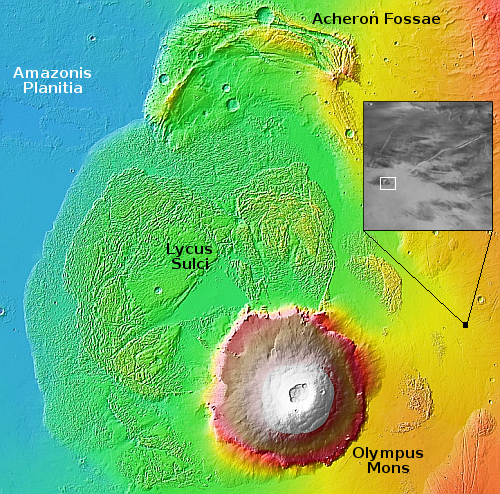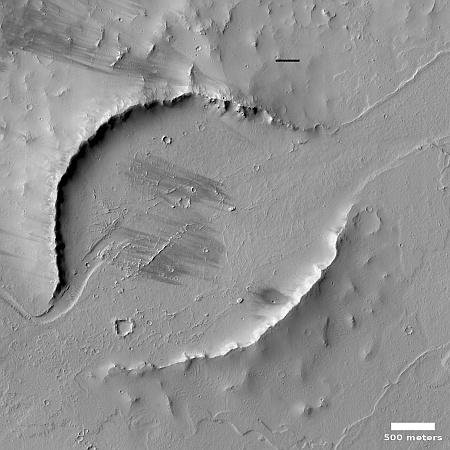Martian lava that buried a crater
Cool image time! The picture to the right, rotated, cropped, reduced, and sharpened to post here, was taken on June 24, 2023 by the high resolution camera on Mars Reconnaissance Orbiter (MRO). It shows a lava flow that cut through an older 2-mile-wide crater, mostly burying it as it burst through the crater’s southwest and northeast rims. From the caption:
A lava channel extends from the feature and continues 60 kilometers to the northeast, growing deeper along its path. The circular formation is likely an eroded impact crater whose walls have been breached by the lava as it surrounded the rim and then infilled the crater. Alternatively, it could represent the location of a volcanic vent that sourced some of the lavas that formed the channel.

The black dot on the overview map to the right marks this location. In the inset you can see that 40-mile-long channel heading to the northeast. Though the giant volcano Olympus Mons is to the west, at this location the downhill grade is from the east to the west, dropping about 900 feet along the full length of that channel. That grade strongly suggests that this crater is not the “volcanic vent that sources some of the lavas that formed the channel.” The flows would have had to go uphill to carve the channel to the east.
Instead, the channel was likely a lava flow related to a 13-mile-crater about 30 miles to the northeast and visible at the edge of the overview map. That crater has a large splash apron, and could have produced enough impact melt to generate this lava tube.
Or maybe the crack formed well after both impacts. Underground pressure spread the surface to form the crack that split the crater in the image above, and lava flowed downhill along that crack to fill the gap in the middle of that crater.
On Christmas Eve 1968 three Americans became the first humans to visit another world. What they did to celebrate was unexpected and profound, and will be remembered throughout all human history. Genesis: the Story of Apollo 8, Robert Zimmerman's classic history of humanity's first journey to another world, tells that story, and it is now available as both an ebook and an audiobook, both with a foreword by Valerie Anders and a new introduction by Robert Zimmerman.
The print edition can be purchased at Amazon or from any other book seller. If you want an autographed copy the price is $60 for the hardback and $45 for the paperback, plus $8 shipping for each. Go here for purchasing details. The ebook is available everywhere for $5.99 (before discount) at amazon, or direct from my ebook publisher, ebookit. If you buy it from ebookit you don't support the big tech companies and the author gets a bigger cut much sooner.
The audiobook is also available at all these vendors, and is also free with a 30-day trial membership to Audible.
"Not simply about one mission, [Genesis] is also the history of America's quest for the moon... Zimmerman has done a masterful job of tying disparate events together into a solid account of one of America's greatest human triumphs."--San Antonio Express-News
Cool image time! The picture to the right, rotated, cropped, reduced, and sharpened to post here, was taken on June 24, 2023 by the high resolution camera on Mars Reconnaissance Orbiter (MRO). It shows a lava flow that cut through an older 2-mile-wide crater, mostly burying it as it burst through the crater’s southwest and northeast rims. From the caption:
A lava channel extends from the feature and continues 60 kilometers to the northeast, growing deeper along its path. The circular formation is likely an eroded impact crater whose walls have been breached by the lava as it surrounded the rim and then infilled the crater. Alternatively, it could represent the location of a volcanic vent that sourced some of the lavas that formed the channel.

The black dot on the overview map to the right marks this location. In the inset you can see that 40-mile-long channel heading to the northeast. Though the giant volcano Olympus Mons is to the west, at this location the downhill grade is from the east to the west, dropping about 900 feet along the full length of that channel. That grade strongly suggests that this crater is not the “volcanic vent that sources some of the lavas that formed the channel.” The flows would have had to go uphill to carve the channel to the east.
Instead, the channel was likely a lava flow related to a 13-mile-crater about 30 miles to the northeast and visible at the edge of the overview map. That crater has a large splash apron, and could have produced enough impact melt to generate this lava tube.
Or maybe the crack formed well after both impacts. Underground pressure spread the surface to form the crack that split the crater in the image above, and lava flowed downhill along that crack to fill the gap in the middle of that crater.
On Christmas Eve 1968 three Americans became the first humans to visit another world. What they did to celebrate was unexpected and profound, and will be remembered throughout all human history. Genesis: the Story of Apollo 8, Robert Zimmerman's classic history of humanity's first journey to another world, tells that story, and it is now available as both an ebook and an audiobook, both with a foreword by Valerie Anders and a new introduction by Robert Zimmerman.
The print edition can be purchased at Amazon or from any other book seller. If you want an autographed copy the price is $60 for the hardback and $45 for the paperback, plus $8 shipping for each. Go here for purchasing details. The ebook is available everywhere for $5.99 (before discount) at amazon, or direct from my ebook publisher, ebookit. If you buy it from ebookit you don't support the big tech companies and the author gets a bigger cut much sooner.
The audiobook is also available at all these vendors, and is also free with a 30-day trial membership to Audible.
"Not simply about one mission, [Genesis] is also the history of America's quest for the moon... Zimmerman has done a masterful job of tying disparate events together into a solid account of one of America's greatest human triumphs."--San Antonio Express-News



Minor edit in first paragraph; “southwest”
Andi: Thank you again. I don’t know what I would do without my readers. Now fixed.